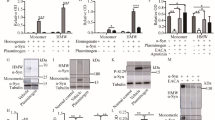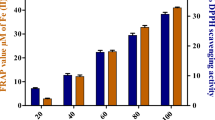Abstract
Our recent studies have demonstrated that green tea polyphenol (−)-epigallocatechin-3-gallate (EGCG) exerts neuroprotective/neurorescue effects against ß-amyloid toxicity and protects neuronal cells from 1-methyl-4-phenyl-1,2,3,6-tetrahydropy-ridinium ion (MPP+) and 6-hydroxydopaminein vitro, or fromN-methyl-4-phenyl-1,2,3,6-tetrahdropyridine-(MPTP-) induced nigral dopaminergic neuronal loss in mice. In the present study, we report that EGCG (0.1 and 1 μM) significantly protects rat pheochromocytoma PC12 cells from apoptosis induced by serum support withdrawal, suggesting that EGCG may play a role in the growth of PC12 cells, where it stimulates survival-promoting pathways.
Similar content being viewed by others
References
Chen C, R Yu, ED Owuor and AN Kong (2000) Activation of antioxidant-response element (ARE), mitogen-activated protein kinases (MARKs) and caspases by major green tea polyphenol components during cell survival and death.Arch. Pharm. Res. 23, 605–612.
Choi YT, CH Jung, SR Lee, JH Bae, WK Baek, MH Suh, J Park, CW Park and SI Suh (2001) The green tea polyphenol (−)-epigallocatechin gallate attenuates beta- amyloid-induced neurotoxicity in cultured hippocampal neurons.Life Sci. 70, 603–614.
Huang NK, YW Lin, CL Huang, RO Messing and Y Chern (2001) Activation of protein kinase A and atypical protein kinase C by A(2A) adenosine receptors antagonizes apoptosis due to serum deprivation in PC12 cells.J. Biol. Chem. 276, 13838–13846.
Kaplan DR and FD Miller (2000) Neurotrophin signal transduction in the nervous system.Curr. Opin. Neurobiol. 10, 381–391.
Lee S, S Suh and S Kim (2000) Protective effects of the green tea polyphenol (−)-epigallocatechin gallate against hippocampal neuronal damage after transient global ischemia in gerbils.Neurosci Lett. 287, 191–194.
Levites Y, O Weinreb, G Maor, MBH Youdim and S Mandel (2001) Green tea polyphenol (−)-epigallocatchin-3-gallate prevents N-methyl-4-phenyl-1,2,3,6-tetrahydropyridine-induced dopaminergic neurodegeneration.J. Neurochem. 78, 1073–1082.
Levites, Y, T Amit, MBH Youdim and S Mandel (2002a) Involvement of protein kinase C activation and cell survival/cell cycle genes in green tea polyphenol (−)-epigallocatechin-3-gallate neuroprotective action.J. Biol. Chem. 277, 30574–30580.
Levites Y, MBH Youdim, G Maor and S Mandel (2002b) Attenuation of 6-hydroxydopamine (6-OHDA)-induced nuclear factor-κB (NF-κB) activation and cell death by tea extracts in neuronal cultures.Biochem. Pharmacol. 63, 21–29.
Levites Y, T Amit, S Mandel and MBH Youdim (2003) Neuroprotection and neurorescue against Abeta toxicity and PKC-dependent release of non-amyloidogenic soluble precursor protein by green tea polyphenol (−)-epigallocatechin-3-gallate.FASEB J. 17(8), 952–954.
Matsuoka Y, H Hasegawa, S Okuda, T Muraki, T Uruno and K Kubota (1995) Ameliorative effects of tea catechins on active oxygen-related nerve cell injuries.J. Pharmacol. Exp. Ther. 274, 602–608.
Nijhawan D, N Honarpour and X Wang (2000) Apoptosis in neural development and disease.Annu. Rev. Neurosci. 23, 73–87.
Weinreb O, S Mandel and MBH Youdim (2003a) cDNA gene expression profile homology of antioxidant and their anti-apoptotic and pro-apoptotic activities in human neuroblastoma cells.FASEB J. 17(8), 935–937.
Weireb O, S Mandel and MBH Youdim (2003b) Gene and protein expression profiles of anti-and pro-apoptotic actions of dopamine. R-apomorphine, green tea polyphenol (−)-epigallocatechine-3-gallate and melatonin.Ann. N.Y. Acad. Sci. 993, 351–361; discussion 387–93.
Author information
Authors and Affiliations
Corresponding author
Rights and permissions
About this article
Cite this article
Mandel, S., Reznichenko, L., Amit, T. et al. Green tea polyphenol (−)-epigallocatechin-3-gallate protects rat PC12 cells from apoptosis induced by serum withdrawal. neurotox res 5, 419–424 (2003). https://doi.org/10.1007/BF03033171
Received:
Revised:
Accepted:
Issue Date:
DOI: https://doi.org/10.1007/BF03033171




